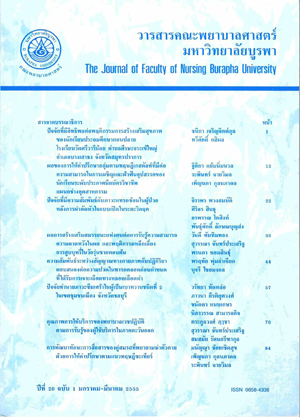คุณภาพการให้บริการของพยาบาลเวชปฏิบัติ ตามการรับรู้ของผู้ใช้บริการ ในภาคตะวันออก
คำสำคัญ:
การรับรู้, คุณภาพการให้บริการ, การพยาบาลเวชปฏิบัติ, คุณภาพการให้บริการของพยาบาลเวชปฏิบัติ, , Perception, Quality of care service, Nurse practitioner, Quality of nurse practitioner care serviceบทคัดย่อ
การวิจัยนี้เป็นการศึกษาคุณภาพการให้บริการของพยาบาลเวชปฏิบัติตามการรับรู้ของผู้ใช้บริการ ในภาคตะวันออก กลุ่มตัวอย่างเป็นผู้ใช้บริการจากพยาบาลเวชปฏิบัติ ในหน่วยบริการสุขภาพระดับปฐมภูมิ จำนวน 400 คน ซึ่งได้จากการสุ่มแบบหลายขั้นตอน เครื่องมือที่ใช้ในการวิจัย เป็นแบบสัมภาษณ์ แบ่งออกเป็น 2 ส่วนคือ คุณลักษณะส่วนบุคคล และคุณภาพการให้บริการ 3 ด้าน คือ ด้านโครงสร้าง ด้านกระบวนการ และด้านผลลัพธ์ วิเคราะห์ความเชื่อมั่นด้วยค่าสัมประสิทธิ์แอลฟาของครอนบาค ได้ค่าความเชื่อมั่น ระดับสูงทั้ง 3 ด้าน (r = .90, .95, .93 ตามลำดับ) พรรณนาข้อมูลทั่วไป โดยการแจกแจงความถี่ ร้อยละ ค่าเฉลี่ย และส่วนเบี่ยงเบนมาตรฐาน ทดสอบความแตกต่างคุณภาพ การให้บริการด้วยสถิติ แมนน์-วิทนีย์ ยู และครัสคาล-วอลลิส วิเคราะห์ความสัมพันธ์ โดยค่าสัมประสิทธิ์สหสัมพันธ์สเปียร์แมน
ผลการวิจัยพบว่าคุณภาพการให้บริการโดยรวม อยู่ในระดับดี (M = 4.42, SD = 0.50 จากคะแนน 5) จำแนกด้านโครงสร้าง ด้านกระบวนการ และด้านผลลัพธ์ มีคะแนนเฉลี่ย ในระดับดี ทุกด้าน (M = 4.35, 4.44 และ4.45, SD = 0.54, 0.55 และ 0.55) ความแตกต่างของการรับรู้คุณภาพการให้บริการพบว่า อายุ ระดับการศึกษาที่แตกต่างกัน มีค่าเฉลี่ยลำดับคุณภาพการให้บริการทุกด้าน แตกต่างกันอย่างมีนัยสำคัญทางสถิติ .05 เพศ และอาชีพที่แตกต่างกัน มีค่าเฉลี่ยลำดับคุณภาพการให้บริการ ด้านกระบวนการ แตกต่างกันอย่างมีนัยสำคัญทางสถิติ .05 และประสบการณ์การมาใช้บริการที่แตกต่างกันมีค่าเฉลี่ยลำดับคุณภาพการให้บริการ ด้านผลลัพธ์ แตกต่างกันอย่างมีนัยสำคัญทางสถิติ .05 และพบว่าคุณภาพการให้บริการด้านโครงสร้าง มีความสัมพันธ์ในทางบวกระดับสูง กับคุณภาพการให้บริการด้านกระบวนการอย่างมีนัยสำคัญ ทางสถิติ ที่ระดับ < .05 (rs = .771, p <.01) และคุณภาพการให้บริการด้านกระบวนการ มีความสัมพันธ์ ในทางบวกระดับสูง กับคุณภาพการให้บริการด้านผลลัพธ์อย่างมีนัยสำคัญทางสถิติ ที่ระดับ < .05 (rs= .748, p < .01)
ผลการวิจัยในครั้งนี้แสดงให้เห็นว่า ผู้ใช้บริการมีความพึงพอใจต่อคุณภาพบริการระดับดี ในทุกด้าน ดังนั้นการพัฒนาพยาบาลเวชปฏิบัติ จึงเป็นกลยุทธ์ที่เหมาะสมสำหรับหน่วยบริการสุขภาพในระดับปฐมภูมิ
The purpose of this research was to explore the quality of nurse practitioner care services as perceived by clients in the eastern region. The 400 samples, who was received care services from nurse practitioner at the primary care center, were derived by multistage random sampling. The data was collected using interviews questionnaire including two parts: personal characteristics and three categories of quality of service in structure, process, and output. The questionnaire internal consistency coefficient was high with the Cronbach’ alpha of three domain of . 90, .95 and .93, respectively. Data was analyzed using frequency, mean, standard deviation, Mann-Whitney U test, Spearman’s Rank Correlation Coefficient, and Kruskal-Wallis test.
The results showed that clients’ perception of quality of nurse practitioner care services overall level was at the high level (M = 4.42, SD = 0.50). The quality of service for the structure, process, and output average score were also at the high level (M = 4.35, 4.44 and 4.45; SD= 0.54, 0.55 and 0.55). In addition, clients with different age and education level had statistical difference with quality of nurse practitioner care services in every domain at the significant level of .05. Clients with different occupations had statistical difference with the structure of quality of nurse practitioner care services at the significant level of .05. Clients with different experiences in receiving services had statistical difference with the output of quality of nurse practitioner care services at the significant level of .05. Correlation analysis showed that the structure quality of services had a high positively correlated with the process of quality of services, and the process quality of services had a high positively correlated with output of quality of services at the significant level < .05 (rs = .748, p < .01; rs= .771, p < .01 respectively).
The results of this study show that clients were satisfied with the quality level of services in all aspects. The development of nurse practitioner position should therefore be the ideal strategy for primary health care services.





